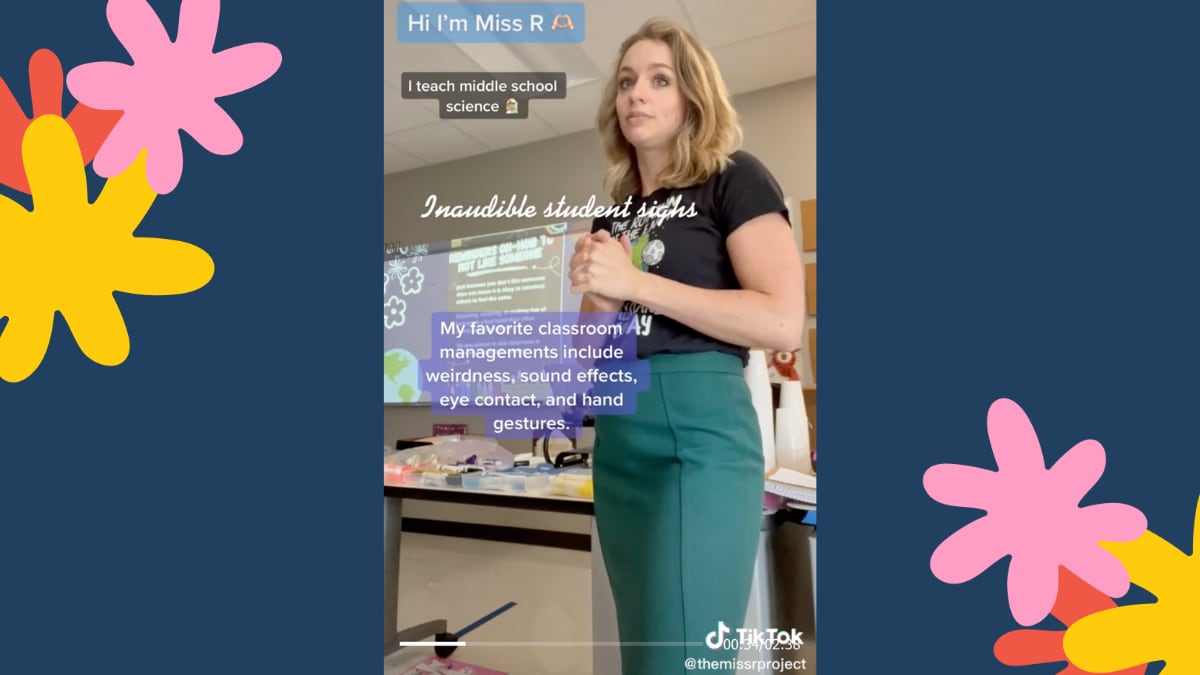From an early age, many kids get messages from their parents and teachers about the importance of being kind. Books and television shows talk about being a good friend, doing good deeds and always being nice to others. But what are kids supposed to do when they encounter people they just don’t click with? Learning how to kindly and respectfully interact with people you don’t like is also an important skill, and that’s why people are applauding Colorado teacher Maddie Richardson for teaching her students a viral lesson on how not to be a friend.
“In middle school, a lot of times we get all caught up on how to be someone’s friend, but no one teaches us how to treat others that we really don’t want to be super close with but we still have to exist with,” Richardson says at the start of her lesson, which she recorded and shared on TikTok.
Richardson reminders her students that middle school is a public setting, which means “everyone has a right to be here.” And while kids may have to interact with people who aren’t their “cup of tea,” that doesn’t mean they’re allowed to resort to mean or bullying behaviors.
With that in mind, she offers them a few simple rules for keeping the peace and maintaining respectful relationships, even with people they don’t want to be friends with. Here are her rules:
- You’re not allowed to convince others not to like someone.
- Other people are allowed to have their own opinions of everyone.
- You’re not allowed to give the silent treatment to people.
- You’re not allowed to leave someone out, make fun of them or isolate them.
- No one person is more important than any other person.
“Every single person, regardless of who they are, will have the right to be treated with kindness, compassion and empathy,” Richardson adds.
Parents say this is an anti-bullying lesson for all ages
Since it was posted, Richardson’s friendship lesson has gotten more than 420,000 likes and 36,000 shares. Thousands of people have also commented to applaud her for taking the time to share such an important message with her students, especially at an age when bullying can be such a serious problem.
“My niece had bullies in junior high,” one person shares. “The last week of school, they cut her hair. She is still dealing with it. I wish more kids got this message. Thank you.”
“I was literally just telling my son about this,” another person adds. “I’m glad to see a teacher educating kids on this. Very well said.”
Others say Richardson’s lesson should be taught over and over again, even among grown-ups.
So love this,” one person writes. “Can we teach this in corporate America? In our neighborhoods? In our churches? Yeah, be a decent human.”
Why is this lesson so important for kids?
About 20% of students ages 12-18 experience bullying nationwide, according to the U.S. Department of Health and Human Services. Students who report being bullied say their bullies exhibit some of the behaviors Richardson warns against, like swaying people’s perceptions of others and having greater social influence. The types of bullying many kids experience also align with Richardson’s warnings:
- 13% say they’re left out or excluded.
- 5.3% say they are made fun of or isolated.
- 13.4% say they are the subject of rumors or lies.
While physical bullying, like the pushing and shoving you might see on after school TV shows, certainly still exists, that’s not the only kind of bullying behavior that takes place in school. And, if kids aren’t educated on all of the different ways they can participate in bullying, they may not even realize it when they’re behaving like a bully.
Richardson understands this firsthand, and she says as much during her lesson.
“You’re 12, so I’m guessing you’ve probably been pretty bad at giving people respectful space in the past, and that’s fair,” she explains. “When I was in middle school, I was a bully and I was bullied. I’m sure a lot of you have been on both ends of that spectrum; however, it’s important that you learn and grow from your mistakes so that you don’t keep making them.”
Ultimately, kids may get it wrong sometimes. They are learning and growing, and friendship is complex, especially if they’ve never had a talk about how to not be someone’s friend before. But Richardson says it’s always possible to do better and be a more respectful and kind person going forward.
“If you were bad at creating space with people respectfully in the past, let’s take a deep breath and let it go,” she says. “Remember, today is a new day with a new opportunity to make your world a better place to be.”
That’s a lesson we can use at every age.




